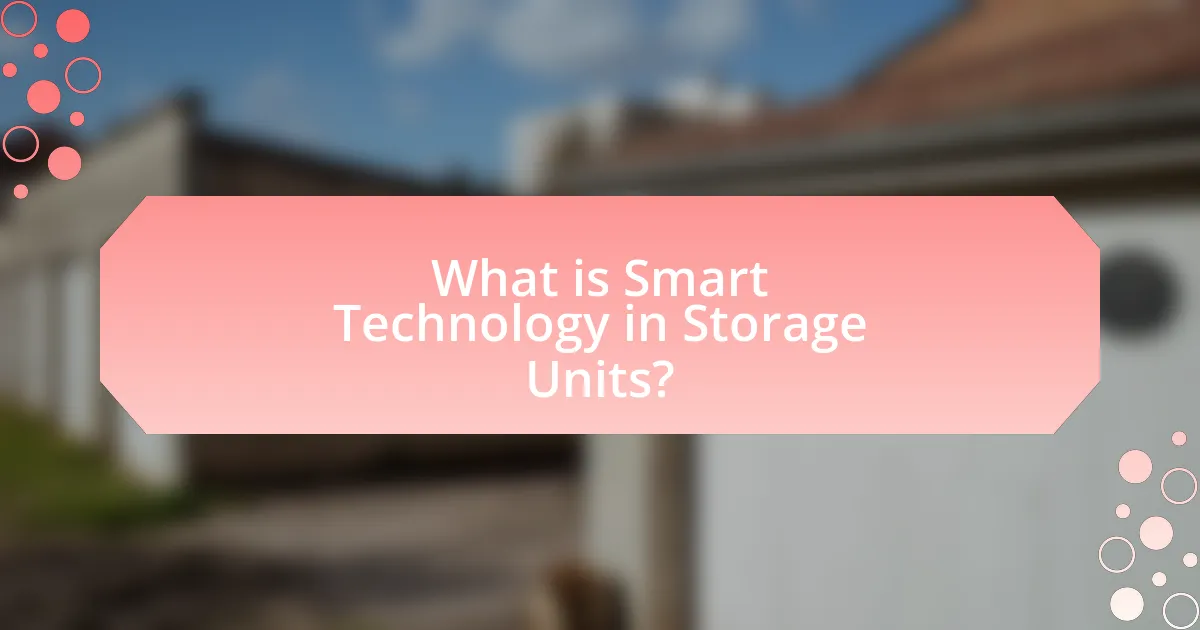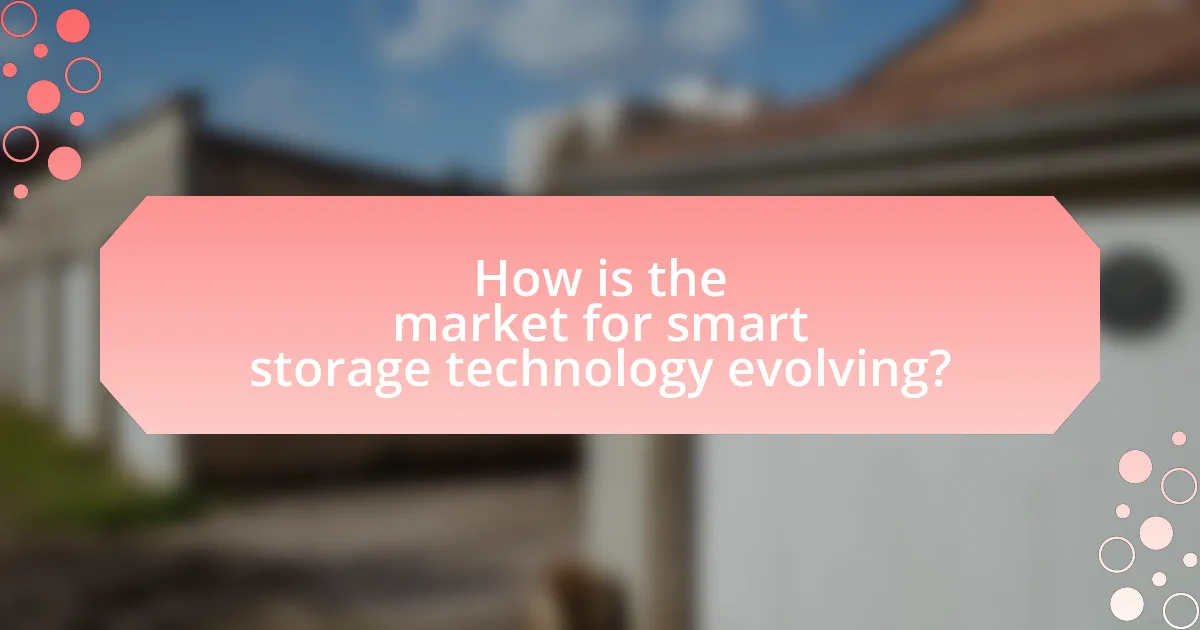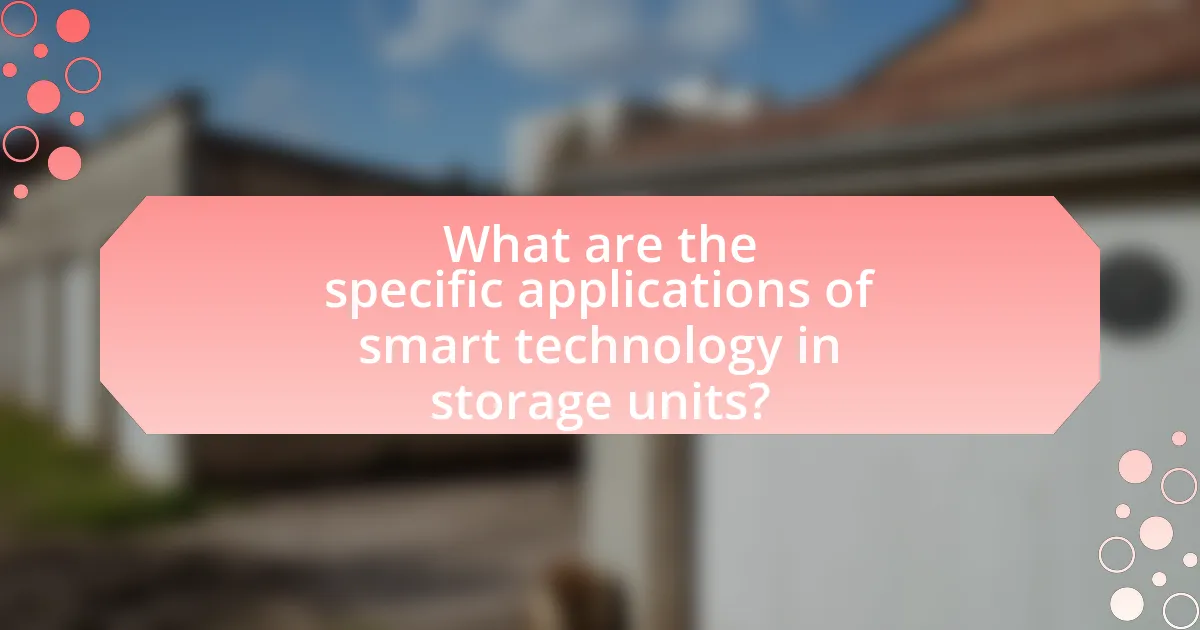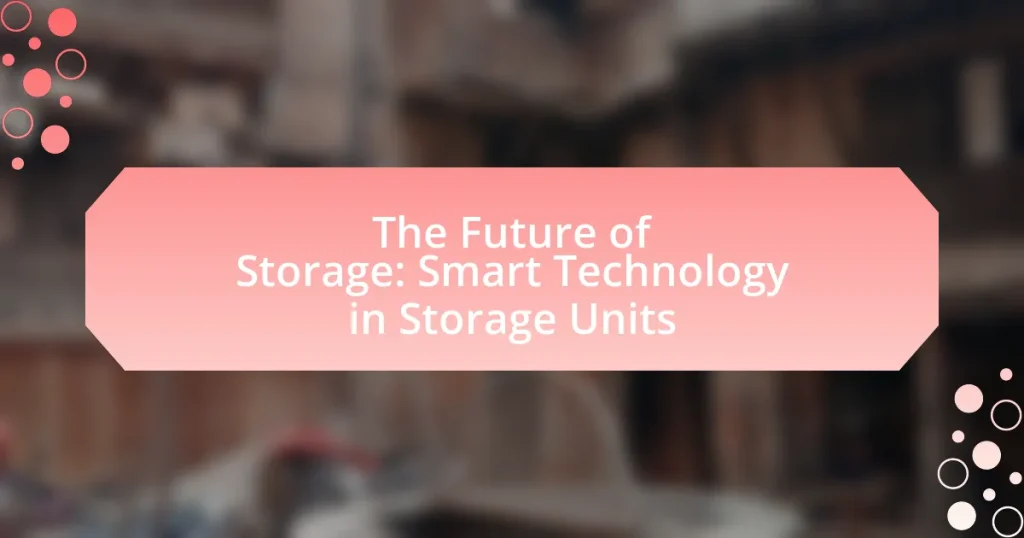Smart technology in storage units refers to the integration of advanced digital systems and IoT devices that enhance security, accessibility, and management of storage spaces. Key features include remote monitoring, automated access controls, climate control systems, and real-time inventory tracking, which collectively improve user experience and operational efficiency. The article explores how smart technology enhances traditional storage units, the benefits it offers, and the evolving market trends, while also addressing challenges such as data security and interoperability. Additionally, it discusses the role of automation and sensors in optimizing inventory management and the implications for storage unit operators.
What is Smart Technology in Storage Units?

 |
|
Smart technology in storage units refers to the integration of advanced digital systems and IoT (Internet of Things) devices that enhance security, accessibility, and management of storage spaces. These technologies often include features such as remote monitoring, automated access controls, climate control systems, and real-time inventory tracking. For instance, smart locks can be controlled via smartphone apps, allowing users to grant access to their units without physical keys. Additionally, sensors can monitor environmental conditions, ensuring optimal storage conditions for sensitive items. This technological advancement improves user experience and operational efficiency in the storage industry.
How does smart technology enhance traditional storage units?
Smart technology enhances traditional storage units by integrating features such as remote access, climate control, and security monitoring. These advancements allow users to manage their storage units via mobile apps, providing real-time updates and control over their belongings. For instance, smart locks enable keyless entry, while sensors can monitor temperature and humidity, ensuring optimal conditions for sensitive items. Additionally, security cameras and motion detectors enhance safety, reducing the risk of theft or damage. These features collectively improve user convenience, security, and the overall management of stored items.
What are the key features of smart storage technology?
Smart storage technology primarily features automation, data analytics, and remote access. Automation allows for efficient management of storage resources, reducing manual intervention and optimizing space utilization. Data analytics provides insights into usage patterns, enabling users to make informed decisions about their storage needs. Remote access facilitates real-time monitoring and control of storage units from anywhere, enhancing convenience and security. These features collectively improve operational efficiency and user experience in storage management.
How do smart storage units differ from conventional units?
Smart storage units differ from conventional units primarily through their integration of technology that enhances security, accessibility, and management. Unlike conventional units, which typically rely on physical locks and manual access, smart storage units utilize features such as remote monitoring, app-based access control, and real-time inventory tracking. For instance, smart units often include built-in sensors and cameras that provide users with live updates and alerts regarding their stored items, significantly improving security and convenience. This technological advancement is supported by the growing trend of IoT (Internet of Things) applications in storage solutions, which has been shown to increase user satisfaction and operational efficiency in the storage industry.
What are the benefits of using smart technology in storage units?
The benefits of using smart technology in storage units include enhanced security, improved accessibility, and efficient management of stored items. Smart technology, such as remote monitoring systems and automated access controls, significantly reduces the risk of theft and unauthorized access, as evidenced by a study from the Self Storage Association, which reported a 30% decrease in security incidents at facilities that implemented smart technology. Additionally, smart storage solutions allow users to access their units remotely via mobile apps, providing convenience and real-time updates on their belongings. This integration of technology streamlines inventory management, enabling users to track and manage their items more effectively, thus optimizing space utilization and reducing costs associated with traditional storage methods.
How does smart technology improve security in storage units?
Smart technology enhances security in storage units by integrating advanced surveillance systems, access control, and real-time monitoring. These systems utilize features such as high-definition cameras, motion sensors, and smart locks that can be controlled remotely via mobile applications. For instance, smart locks allow users to grant access to specific individuals while tracking entry and exit times, thereby reducing unauthorized access. Additionally, real-time alerts can notify owners of any suspicious activity, enabling prompt responses to potential security breaches. According to a report by the Security Industry Association, facilities equipped with smart technology experience a 30% reduction in theft incidents compared to traditional storage units, demonstrating the effectiveness of these innovations in enhancing security.
What cost savings can be achieved with smart storage solutions?
Smart storage solutions can achieve significant cost savings by optimizing space utilization and reducing operational expenses. These solutions often incorporate advanced technologies such as IoT sensors and automated inventory management, which minimize wasted space and enhance efficiency. For instance, a study by the Storage Association found that facilities implementing smart storage technologies reported up to a 30% reduction in overhead costs due to improved space management and decreased labor requirements. Additionally, smart storage can lower energy costs through automated climate control systems that adjust based on real-time data, further contributing to overall savings.
How is the market for smart storage technology evolving?

 |
|
The market for smart storage technology is rapidly evolving, driven by advancements in IoT, AI, and consumer demand for efficiency. According to a report by MarketsandMarkets, the smart storage market is projected to grow from $12.5 billion in 2020 to $30.5 billion by 2025, reflecting a compound annual growth rate (CAGR) of 19.5%. This growth is fueled by the increasing need for data management and the integration of smart features in storage solutions, such as remote monitoring and automated inventory management. Additionally, the rise of smart homes and businesses is further propelling the adoption of smart storage technologies, as consumers seek more convenient and secure storage options.
What trends are shaping the future of smart storage units?
The future of smart storage units is being shaped by trends such as increased automation, enhanced security features, and integration with IoT technology. Automation allows for streamlined operations, enabling users to manage their storage remotely through mobile applications. Enhanced security features, including biometric access and real-time surveillance, provide greater peace of mind for users. Integration with IoT technology facilitates smart inventory management, allowing users to track their belongings in real-time. According to a report by MarketsandMarkets, the smart storage market is expected to grow significantly, driven by these technological advancements and the rising demand for efficient storage solutions.
How are consumer preferences influencing smart storage technology?
Consumer preferences are significantly shaping the development of smart storage technology by driving demand for features that enhance convenience, security, and efficiency. As consumers increasingly prioritize ease of use and integration with smart home systems, manufacturers are responding by incorporating advanced functionalities such as remote access, automated inventory management, and real-time monitoring. For instance, a survey by Statista in 2022 indicated that 70% of consumers prefer storage solutions that can be controlled via mobile applications, highlighting the trend towards mobile connectivity in storage technology. This shift in consumer expectations is prompting companies to innovate and offer products that align with these preferences, ultimately influencing the direction of smart storage technology advancements.
What role do startups play in the smart storage market?
Startups play a crucial role in the smart storage market by driving innovation and introducing new technologies that enhance storage efficiency and user experience. These companies often focus on developing advanced solutions such as IoT-enabled storage systems, automated inventory management, and data analytics tools that optimize space utilization. For instance, startups like Stowga and Cubiq have pioneered platforms that connect users with available storage spaces, leveraging technology to streamline the process. Their contributions not only foster competition but also accelerate the adoption of smart storage solutions across various sectors, ultimately shaping the future landscape of storage technology.
What challenges does the smart storage technology industry face?
The smart storage technology industry faces significant challenges including data security, interoperability, and high implementation costs. Data security is a primary concern as smart storage systems often store sensitive information, making them targets for cyberattacks; a report by Cybersecurity Ventures predicts that cybercrime will cost the world $10.5 trillion annually by 2025, highlighting the urgency for robust security measures. Interoperability issues arise as various smart storage solutions may not seamlessly integrate with existing systems, leading to inefficiencies; a study by Gartner indicates that 70% of organizations struggle with integrating new technologies. Additionally, the high costs associated with implementing smart storage technologies can deter businesses from adopting these innovations, as initial investments can be substantial, often exceeding $100,000 for comprehensive systems.
How do privacy concerns impact the adoption of smart storage solutions?
Privacy concerns significantly hinder the adoption of smart storage solutions. Many potential users fear that their personal data, which may be collected and stored by these systems, could be accessed by unauthorized parties or misused. A survey conducted by the Pew Research Center found that 81% of Americans feel they have little to no control over the data collected about them, highlighting widespread apprehension regarding data privacy. This fear leads to reluctance in embracing smart storage technologies, as individuals prioritize the security of their personal information over the convenience these solutions offer.
What technological barriers exist for widespread implementation?
Technological barriers for widespread implementation of smart technology in storage units include high costs, interoperability issues, and data security concerns. High costs hinder adoption as advanced smart technologies often require significant initial investment, making them less accessible for smaller storage facilities. Interoperability issues arise when different smart devices and systems fail to communicate effectively, complicating integration and limiting functionality. Data security concerns are paramount, as the increased connectivity of smart devices raises the risk of cyberattacks, leading to potential breaches of sensitive customer information. These barriers collectively impede the seamless integration of smart technology in the storage industry.
What are the specific applications of smart technology in storage units?

 |
|
Smart technology in storage units is applied through features such as remote monitoring, automated access control, and climate control systems. Remote monitoring allows users to track their storage unit’s status in real-time via mobile apps, enhancing security and convenience. Automated access control utilizes smart locks and keyless entry systems, enabling users to enter their units without physical keys, thus improving security and ease of access. Climate control systems maintain optimal temperature and humidity levels, protecting sensitive items from damage. These applications collectively enhance user experience, security, and item preservation in storage units.
How do smart sensors improve inventory management in storage units?
Smart sensors enhance inventory management in storage units by providing real-time data on stock levels, location, and environmental conditions. These sensors utilize technologies such as RFID, IoT, and temperature monitoring to track inventory movement and status continuously. For instance, a study by the International Journal of Production Economics found that implementing smart sensors can reduce inventory holding costs by up to 30% and improve order accuracy by 25%. This data-driven approach allows for timely restocking, minimizes stockouts, and optimizes space utilization, ultimately leading to more efficient operations and reduced waste.
What types of sensors are commonly used in smart storage units?
Commonly used sensors in smart storage units include temperature sensors, humidity sensors, motion detectors, and door sensors. Temperature sensors monitor the internal climate to protect sensitive items, while humidity sensors help prevent mold and damage to stored goods. Motion detectors enhance security by detecting unauthorized access, and door sensors provide alerts when storage units are opened or closed. These sensors collectively contribute to the effective management and security of stored items, ensuring optimal conditions and safety.
How do these sensors enhance user experience and efficiency?
Sensors enhance user experience and efficiency by providing real-time monitoring and automation in storage units. These sensors track environmental conditions such as temperature and humidity, ensuring optimal storage conditions for sensitive items. For instance, a study by the International Journal of Refrigeration found that maintaining specific temperature ranges can reduce spoilage in perishable goods by up to 30%. Additionally, motion sensors can alert users to unauthorized access, enhancing security and peace of mind. This integration of technology streamlines operations, reduces manual oversight, and ultimately leads to a more efficient storage experience.
What role does automation play in smart storage units?
Automation plays a crucial role in smart storage units by enhancing efficiency, security, and user convenience. Smart storage units utilize automated systems for access control, inventory management, and monitoring, allowing users to manage their belongings remotely through mobile applications. For instance, automated locking mechanisms and surveillance systems provide real-time security updates, reducing the risk of theft or unauthorized access. Additionally, automated inventory tracking helps users keep an accurate count of their stored items, streamlining the organization process. These features demonstrate how automation significantly improves the functionality and appeal of smart storage solutions.
How can automation streamline the storage and retrieval process?
Automation can streamline the storage and retrieval process by utilizing advanced technologies such as robotics, artificial intelligence, and automated inventory management systems. These technologies enhance efficiency by reducing human error, speeding up the sorting and locating of items, and optimizing space utilization. For instance, automated storage and retrieval systems (AS/RS) can manage inventory with precision, allowing for faster access to stored items and minimizing the time spent searching for products. According to a study by the Warehouse Education and Research Council, companies that implemented automation in their storage processes reported a 30% increase in efficiency and a significant reduction in operational costs.
What are the implications of automation for storage unit operators?
Automation significantly impacts storage unit operators by enhancing operational efficiency and reducing labor costs. Automated systems streamline processes such as inventory management, customer access, and payment processing, allowing operators to manage facilities with fewer staff. For instance, self-service kiosks and mobile apps enable customers to rent units and make payments without direct interaction with staff, which can lead to a 30% reduction in operational costs, as reported by the Self Storage Association. Additionally, automation improves security through advanced surveillance systems and access controls, reducing the risk of theft and damage. Overall, the implications of automation for storage unit operators include increased efficiency, cost savings, and enhanced security measures.
What are the best practices for utilizing smart technology in storage units?
The best practices for utilizing smart technology in storage units include implementing advanced security systems, utilizing climate control features, and integrating inventory management software. Advanced security systems, such as smart locks and surveillance cameras, enhance safety by allowing remote monitoring and access control. Climate control features help protect sensitive items by maintaining optimal temperature and humidity levels, which is crucial for preserving items like electronics and documents. Integrating inventory management software streamlines tracking and organization, enabling users to easily locate and manage their stored items. These practices collectively improve efficiency, security, and item preservation in storage units.
How can users maximize the benefits of smart storage technology?
Users can maximize the benefits of smart storage technology by integrating it with their daily routines and utilizing its features effectively. This includes leveraging automated inventory management systems that track items in real-time, which can reduce time spent searching for belongings and enhance organization. Additionally, users should take advantage of remote access capabilities, allowing them to monitor and manage their storage units from anywhere, thus increasing convenience and security. Studies show that smart storage solutions can improve efficiency by up to 30% compared to traditional storage methods, highlighting the tangible benefits of adopting these technologies.
What common mistakes should be avoided when implementing smart storage solutions?
Common mistakes to avoid when implementing smart storage solutions include inadequate planning, neglecting user training, and failing to integrate with existing systems. Inadequate planning can lead to mismatched technology and user needs, resulting in inefficiencies. Neglecting user training can cause underutilization of features, as users may not fully understand how to leverage the technology effectively. Additionally, failing to integrate smart storage solutions with existing systems can create data silos, hindering overall operational efficiency. These mistakes can significantly impact the effectiveness of smart storage implementations, as evidenced by case studies showing that organizations with comprehensive planning and training achieve up to 30% higher efficiency in storage management.


